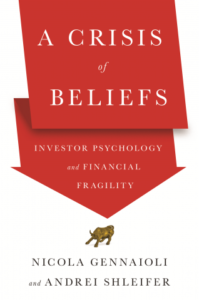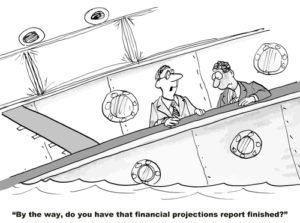Predictable Irrationality and the Crisis of 2008
By Arnold Kling


A decade after the financial crisis of 2008 and its aftermath, economists are still grappling with its nature and significance. An important recent contribution is A Crisis of Beliefs, by Nicola Gennaioli and Andrei Shleifer (henceforth GS).1 They tell the story this way (page 7):
- Homebuyers were unrealistically optimistic about future home price growth. Investors in mortgages and in securities backed by these mortgages, including financial institutions, considered the possibility that home prices might fall but did not fully appreciate how much and what havoc those declines would wreak. And macroeconomic forecasters from both the private sector and the Federal Reserve did not, in forming their expectations, recognize the risks facing the U.S. financial sector and the economy as late as the summer of 2008… they did not fully appreciate tail risks until the Lehman collapse [the investment bank went bankrupt in September of 2008] laid them bare.
Explanations of the financial crisis tend to fall into two broad categories. One category is “moral failure,” in which actors took bad risks because they faced perverse incentives that encouraged them to do so. This included bankers with the status of “too big to fail.” The other category is “cognitive failure,” in which actors took bad risks unintentionally based on poorly specified forecasting models.2
For example, Susan Gates tells the story of the collapse of Freddie Mac, the housing finance giant, as a moral failure. Its top executives saw little or no personal risk from lowering underwriting standards for mortgage loans.3
On the other hand, I would put Jeffrey Friedman and Wladimir Kraus in the camp of arguing for cognitive failure.4 They point out that if banks had truly wished to exploit “too big to fail” status, they could have employed even lower ratios of capital to assets. In fact, banks exceeded required capital ratios—it was the regulators who under-estimated the prudent capital requirements for mortgage securities.
Most economists seem to prefer the “moral failure” explanations. But GS argue, and I agree, that cognitive failure was the primary factor.
Against “rational expectations”
GS directly attack the hypothesis of “rational expectations,” which has dominated the economics profession for forty years. The rational-expectations doctrine holds that when economic actors make decisions that require forecasts, they make optimal use of the available information. They are not guilty of predictable irrationality.
As an alternative to rational expectations, GS propose what they call “diagnostic expectations.” Unfortunately, the modifier “diagnostic” gives no hint to what they have in mind. For me, a better (but still imperfect) term would be “recency-biased” expectations.
Think of a forecast as employing two types of information about a variable being forecast. One is a “base rate,” which is a very generic property of the variable. The other is “recent information” about that variable or about factors that could affect that variable. Recency-biased forecasting over-weights the recent information and under-weights the base rate.5

GS use the example of estimating the probability that an Irish person will have red hair. Many people will over-estimate that probability, giving an estimate of fifty percent or more. The “diagnostic” or “recent” information is that the person is Irish, and it is true that red hair is more prevalent among Irish than elsewhere in the population. But the base rate of red hair in the population is so low that even for an Irish person the incidence of red hair is only 10 percent.
Consider the average of inflation-adjusted house prices. In the long run, the average tends to remain constant. Thus the long-run base rate for inflation-adjusted home price appreciation is zero. But in the short run, inflation-adjusted home prices can be high or low. A recency-biased forecast of home prices in the near term would put too little weight on the base rate and too much weight on the expectation of continuation of recent trends.
Compound errors
Until 2007, recency-biased forecasting suggested that:
1. House prices would continue to rise;
2. Financial institutions with large holdings of mortgage-backed securities were safe; investors under-estimated “tail risk,” meaning the chance of an extreme adverse event.
3. The economy would avoid a bad recession, because the Federal Reserve could maintain what was then called “The Great Moderation.”
What caused people to change these forecasts? GS focus on the Lehman bankruptcy, but this at most explains only number (2). The change in people’s outlook for house prices took place earlier, and the depth of the recession only became evident later.
The expectations for house prices were bound to change once people saw the problems that emerged in the sub-prime mortgage sector. For example, New Century Mortgage, a high-flying sub-prime mortgage lender, went bankrupt in April of 2007, and this clearly signaled that the era of ever-surging house prices had ended. GS do agree that belief in (1) had changed well before the Lehman bankruptcy, which came 18 months later.
I am not sure that the expectation (3) changed when Lehman went bankrupt. Instead, the severity of the recession is something that became clear only in hindsight.
Macroeconomic forecasts even six months later suggested that the unemployment rate would remain below 8.5 percent, incorporating the (correct) assumption that a large fiscal stimulus package would be enacted.6 In fact, the unemployment rate soared over 10 percent.
Moreover, there was little in the way of economic theory that would have predicted such a deep recession. There were no mainstream economic models incorporating a direct linkage between banking-sector distress and economic activity. Even today, some economists prefer to blame the recession on the decline in household wealth due to lower home prices. GS mention the work of Atif Mian and Amir Sufi, who
- … suggest that the United States would have had a major recession even without the financial crisis, since the households lost so much wealth after the housing price collapse. (page 43)
GS do also point out that a reduction in bank lending could be a factor that caused the recession to be as deep as it was. But if Mian and Sufi are correct, then GS are overstating the impact of the Lehman bankruptcy and other developments that affected Wall Street more than Main Street.
Personally, I find it difficult to have confidence in any explanation for the sharp rise in unemployment that took place in 2009. It might just be that the economy was subject to a secular decline in business dynamism, and this became unsustainable in 2009.7
Lately, I have been wondering about the effects of the regulatory zeal of the administration that took office in 2009, which may have impeded the creation and growth of new firms. I came to this hypothesis because the reversal of this regulatory zeal by the administration that took office in 2017 seems to have prolonged and strengthened the economic expansion beyond what some forecasters saw as likely.
Strengths and Weaknesses
Overall, I see GS as having the following strengths:
1. They make a convincing case for taking seriously the evidence provided by surveys and anecdotes that characterize the beliefs held at the time by households, investors, and policy makers. Too many economists instead have had the arrogance to impose “rational expectations” as a modeling assumption, ignoring actual expectations of market participants.
2. This in turn opens up consideration of the possibility of cognitive failure as an explanation for the crisis. It is important to give this possibility due consideration.
3. As GS point out, their “diagnostic” (or recency-biased) expectations can explain various puzzling phenomena, not just the financial crisis.
But I also see the following weaknesses.
1. Like most mainstream economists, they prefer analytical mathematical models that overlook institutional detail. I have more admiration for Richard Bookstaber’s willingness to dive into the complexity of the modern financial system.8
Indeed, even though it does not affect their analysis, GS seem to me to be quite mistaken on at least one institutional point. On page 27, they speak of “AAA-rated senior tranches of MBS,” confusing a mortgage-backed security with a collateralized debt obligation (CDO). CDOs have tranches, while MBS do not. GS proceed to describe as a CDO a re-securitized tranched security, which on Wall Street was known instead as a “CDO squared.”
2. Although the hypothesis of “diagnostic expectations” may be more realistic than “rational expectations,” both share the weakness of ignoring heterogeneity of expectations. In either case, diversity of beliefs is replaced by a “representative agent.” But the surveys GS justifiably use to study expectations exhibit differences in beliefs, which GS override by taking averages.
I think it is likely that market dynamics are affected by the evolution of diverse beliefs. Over time, investors whose beliefs turn out to be correct will accumulate more resources and have more influence on prices. Even if individual forecasts were not recency-biased, the market as a whole could show recency bias because of this mechanism, in which those who have been correct recently are rewarded.
This in turn potentially gives rise to a connection between moral failure and cognitive failure. If firms that ignore tail risk are bailed out rather than allowed to go bankrupt, then this aborts the evolutionary mechanism for weeding out executives who ignore tail risk. The moral failure of “too big to fail” leads to the cognitive failure of overly aggressive market forecasts, because the overly aggressive participants stay in the game.
The financial crisis of 2008 may be fading into economic history. But like other complex historical events, including the Industrial Revolution and the Great Depression, it is likely to continue to provide a basis for thought and debate for a long time.
Footnotes
[1] Nicola Gennaioli and Andrei Shleifer, A Crisis of Beliefs: Investor Psychology and Financial Fragility. Princeton University Press, 2018.
[2] See my essay, “The financial crisis: Moral failure or cognitive failure?” Harvard journal of law and public policy, March 2010.
[3] See “Present at the Destruction”, by Arnold Kling. Library of Economics and Liberty, April 3, 2017.
[4] See “The Regulator’s Calculation Problem”, by Arnold Kling. Library of Economics and Liberty, April 6, 2015.
[5] See “Philip Tetlock on Superforecasting”. EconTalk, December 2015.
[6] See for example, the Congressional Budget Office forecast in table 3 of this memo: https://www.cbo.gov/sites/default/files/111th-congress-2009-2010/reports/03-02-macro_effects_of_arra.pdf.
[7] See Ryan A. Decker, et al, Declining Business Dynamism: Implications for Productivity?. Brookings, Sep. 19, 2016.
[8] See “The Practitioner’s Challenge”, by Arnold Kling. Library of Economics and Liberty, July 3, 2017.
*Arnold Kling has a Ph.D. in economics from the Massachusetts Institute of Technology. He is the author of several books, including Crisis of Abundance: Rethinking How We Pay for Health Care; Invisible Wealth: The Hidden Story of How Markets Work; Unchecked and Unbalanced: How the Discrepancy Between Knowledge and Power Caused the Financial Crisis and Threatens Democracy; and Specialization and Trade: A Re-introduction to Economics. He contributed to EconLog from January 2003 through August 2012.
Read more of what Arnold Kling’s been reading. For more book reviews and articles by Arnold Kling, see the Archive.
